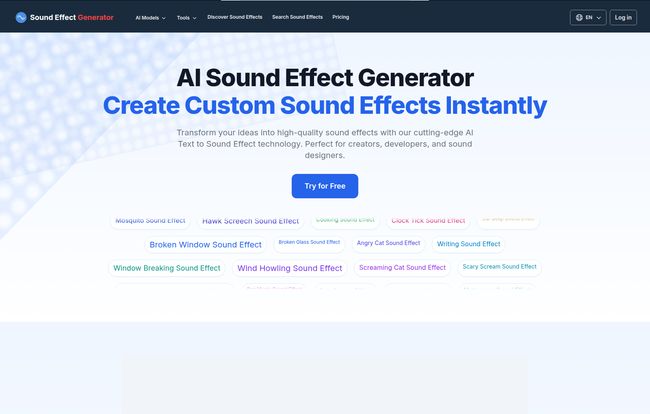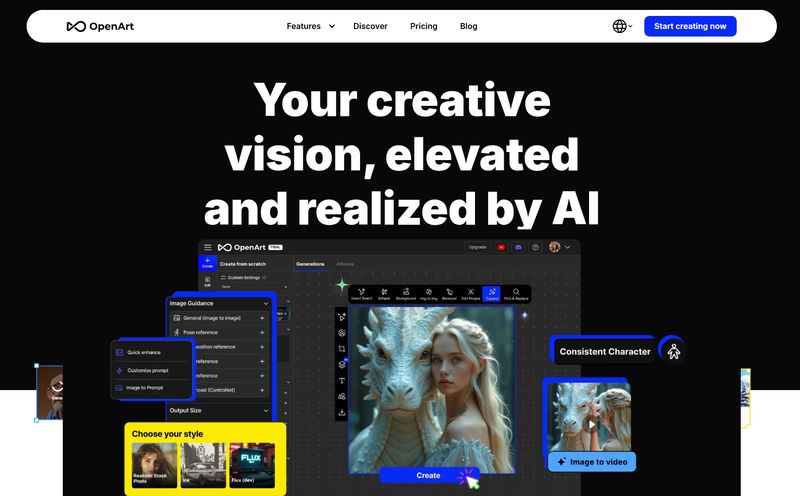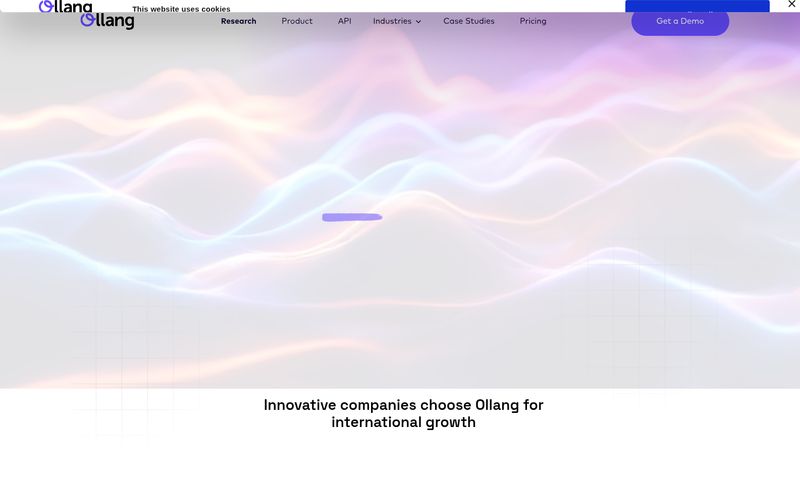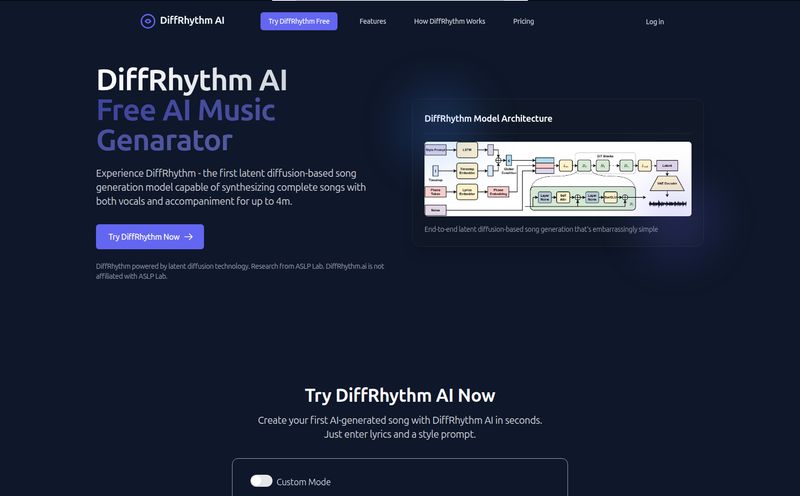How many hours have you lost scrolling through stock audio sites? You know the drill. You type in “footsteps on gravel,” listen to twenty variations that sound like someone crunching cereal, and finally settle for one that’s just… fine. It’s the content creator’s eternal struggle: finding the perfect sound effect that doesn’t cost a fortune or sound like it was recorded in a tin can in 1998.
For years, this has been my reality. As an SEO guy and blogger, I’m constantly dabbling in video and podcasts. Audio is half the experience, right? But the search for good, unique audio has always been a major bottleneck. A real pain.
Then I stumbled upon something that felt a bit like cheating. An AI-powered tool called, simply, Sound Effect Generator. The premise is wild. You type what you want to hear, and a machine… makes it. Just like that. My inner skeptic immediately rolled his eyes, but the curious creator in me had to give it a shot. And wow. I’m glad I did.
What Exactly is This Sound Effect Generator?
At its heart, it’s a creative tool that uses artificial intelligence to generate audio from a text description. You type in “a heavy wooden door creaking open in a haunted mansion,” and it spits out a sound file. Simple as that. No more searching, no more settling. You become the composer of your own audio world.
But looking at their main page, it’s clear they’re aiming for more than just a one-trick pony. It’s an entire suite of AI audio tools. We’re talking music generation, text-to-speech, and even AI voice cloning. It’s a whole creative sandbox built around sound.
The interface is clean, almost deceptively simple. You’ve got a big text box, a couple of dropdowns for the AI model, and a giant blue “Generate Sound” button. It’s inviting. It doesn’t scream “you need an audio engineering degree to use this.” Which I appreciate.

Visit Sound Effect Generator
Putting the AI to the Test: My First Prompts
Okay, so time to see if this thing is legit. I started with something basic: “softly crackling fireplace.” I hit generate, waited about 30 seconds, and… it was good. Like, really good. It had the warmth, the occasional pop, the gentle hiss. It wasn’t a sterile loop; it felt alive.
Feeling bolder, I decided to get weird with it. How about… “a robot bartender sliding a crystal glass across a metal counter in a noisy sci-fi cantina.”
Now, this is the kind of prompt that would send you down a rabbit hole for hours on a traditional stock site. You’d be layering three, maybe four different sounds to get it right. The first result the AI gave me was… interesting. It sounded less like a sci-fi cantina and more like my dishwasher having an existential crisis. A bit of a miss. But I tweaked the prompt slightly—adding “smooth metallic sliding sound” and “distant alien chatter”—and tried again. The second attempt was shockingly close to what I had in my head. The slide, the clink, the ambient noise. It was all there. This is where the magic lies: not just in the generation, but in the iteration. You can refine your ideas in real-time.
They also have a feature to generate sound from a video upload, which is a massive deal for video editors and foley artists. Imagine dropping in a silent clip of someone walking and having the AI generate the footsteps for you. The potential time savings there is just staggering.
More Than Just Noises: A Look at the Full Suite
While the SFX generator is the main event, the other tools are worth a mention because they create a more complete ecosystem for creators.
Music and Song Generation
I played around with the music generator, asking for a “lo-fi chillhop beat for studying.” It produced a perfectly serviceable, royalty-free track that I could easily loop in the background of a YouTube video. It’s not going to replace a human composer for a film score, but for background music for content? It’s an incredibly powerful feature to have under the same roof.
Voice and Speech Tools
The text-to-speech and voice cloning tools are… potent. The TTS is solid, great for quick voiceovers. The voice cloning is the kind of tech that makes you go, “whoa.” You can create a digital replica of a voice. Of course, this walks into some tricky ethical territory, and it’s something creators need to be mindful of. But for legit uses, like having a consistent voice for your brand’s content, it’s a powerful option.
The Free Sound Effect Library
If you’re not quite ready to start directing an AI, there’s a public library of sounds others have generated. It’s a great way to grab something quickly or just to see what the AI is capable of. It’s a smart move, giving users a taste of the quality before they even type a word.
The Good, The Bad, and The Quirky
No tool is perfect, right? After spending a few days with it, here’s my honest breakdown.
The good stuff is pretty obvious. The speed and convenience are off the charts. The ability to create a completely custom sound in under a minute is a paradigm shift for solo creators and small teams. It’s incredibly user-friendly; if you can write a sentence, you can make a sound effect. And the fact that there’s a free tier means there's literally no barrier to trying it out. For anyone creating professional content, the availability of a commercial license with the paid plans is crucial.
Now for the not-so-good stuff. The free generations are limited, which is fair, but you’ll burn through them quickly if you're experimenting a lot. And if you want to use your creations in a monetized project, you have to be on a paid plan. That’s standard, but it’s a hard line for hobbyists who might want to make a few bucks from their YouTube channel. Also, while many generations are fast, the more complex your prompt, the longer it can take. “Instant” sometimes means a couple of minutes. Patience is a virtue, I guess.
Let's Talk Money: Is the Price Right?
So, what’s this all cost? The pricing is subscription-based, using a credit system. This actually makes a lot of sense for this kind of service.
Here's a simplified look at the monthly plans:
| Plan | Price (Monthly) | Credits | Best For |
|---|---|---|---|
| Basic | $9.99 | 7,000 + 1,000 Bonus | Regular Content Creators, Podcasters |
| Standard | $19.99 | 14,000 + 2,000 Bonus | Heavy Users, YouTubers, Indie Devs |
| Premium | $29.99 | 21,000 + 3,000 Bonus | Agencies, Professional Sound Designers |
The important thing to know is the credit usage: 1 credit per second for text-to-sound and 2 credits per second for video-to-sound. So a 10-second sound effect from text costs 10 credits. A 10-second audio track for a video costs 20. It's pretty straightforward.
Is it worth it? Compare it to the alternatives. A single high-quality sound effect from a premium stock site can cost $5 to $20. One sound. With the basic $9.99 plan, you can generate thousands of seconds of custom audio. For anyone who regularly produces content, the value proposition is a no-brainer.
Who Should Actually Use This Tool?
This isn't just for one type of person. I can see it being a game-changer for a whole range of creators:
- YouTubers & Podcasters: Need a unique intro stinger, custom sound effects for a skit, or seamless background ambience? This is your new best friend.
- Indie Game Developers: Working on a budget but need a rich soundscape for your game? You can generate everything from monster growls to weapon sounds without breaking the bank.
- Social Media Managers: Want to make your Instagram Reels or TikToks pop with unique audio? Done.
- Dungeon Masters: This is a slightly niche one, but I got so excited thinking about it. Imagine describing a scene in your D&D campaign and then playing the exact sound of the “glowing magical orb humming with ancient power.” That’s next-level immersion.
My Final Thoughts
The rise of generative AI has been met with a mix of excitement and trepidation, and for good reason. But tools like Sound Effect Generator show the incredible potential for AI to act as a creative partner, not a replacement. It removes the tedious parts of a workflow—like endlessly searching for the right sound—and lets you focus on the creative part: the idea itself.
It’s not perfect. It still has its quirks and sometimes misunderstands you, like a creative partner who’s had too much coffee. But its trajectory is clear. This technology is getting better at an exponential rate. For now, it’s an unbelievably powerful, accessible, and frankly, fun tool that has earned a permanent spot in my creative toolkit.
If you're a creator of any kind, you owe it to yourself to give the free version a spin. Go on. Think of the weirdest sound you can imagine and see what happens. You might just be surprised.
Frequently Asked Questions
- How does the AI sound generator actually work?
- It uses advanced machine learning models, trained on vast datasets of audio and text descriptions. When you input a prompt, the AI analyzes the language and synthesizes a new audio waveform based on the patterns it has learned, effectively translating your words into sound.
- Can I use the sounds I create for commercial projects?
- Yes, but only with a paid subscription. The paid plans grant you commercial usage rights, allowing you to use the generated audio in monetized YouTube videos, podcasts, games, and other commercial products. The free plan is for personal, non-commercial use only.
- What’s the real difference between the free and paid plans?
- The main differences are the number of credits (you get far more with paid plans), access to premium features like private sound effects, and the all-important commercial license. Paid plans are also ad-free and generally offer faster generation speeds.
- Are the AI-generated sounds truly unique and copyright-free?
- The sounds are synthesized by the AI, making them new and unique creations. With a paid plan that includes a commercial license, you have the right to use them in your projects. This helps you avoid the copyright strikes that can come from using mislabeled audio from the web.
- How many credits will I actually need?
- It depends on your usage. Remember the formula: 1 credit per second for text-to-sound. If you primarily create short, 3-5 second SFX for videos, the basic $9.99 plan (with 7,000 credits) gives you over 100 minutes of generated audio, which is a massive amount for most creators.
- Does it support languages other than English?
- Yes, the platform supports multiple languages for prompts. This is a great feature for international creators who want to generate sounds based on descriptions in their native language.



